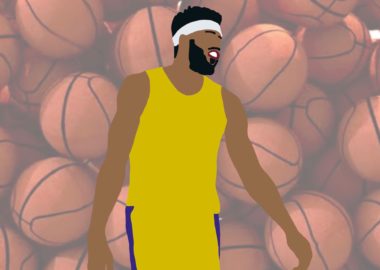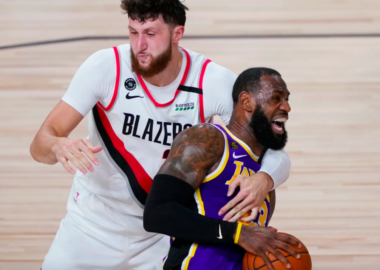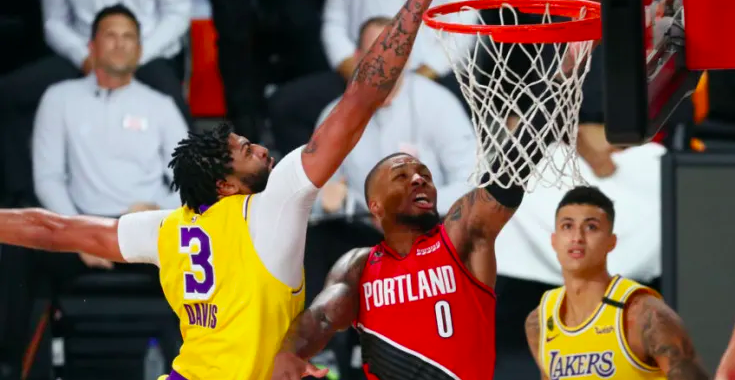
It’s important to not get too high or too low off of any single game, but this was a critical win for the Lakers. The defense was excellent, holding Portland’s point total and efficiency down incredibly well, and only giving up 1 run from Q1-3, and it was a 5-0 tiny run.
One cool fact to start this off with is that for the whole series, AD & LeBron have both been off the court at the same time for a total of 13 seconds.
The Trail Blazer Offense
Set Plays
We’re going to start with them, because Portland started the game off with a lot of them in direct response to LA not playing them correctly in game 1.
Mover-Blocker: was run 3 times before garbage time
My guidance pre-series was to lock & trail the flare screen, meaning you just follow the shooter and stay behind him to try to deter the pass and be in position to contest if he does get it.
What that concedes to the offense is that shooter curling to the rim, but that’d be something McCollum has done only 6 times in 70 total games this season before the series, Trent did 5 times, Dame did just once, and Melo hasn’t done at all. So that likely locks that action down.
For the pin downs, my guidance was to go under the screen, rather than trail, to meet the shooter at the 3-point line where they’d likely catch.
What that concedes to the offense is for the offensive player to fade to the corner, but again, that’s something that Portland’s shooters almost never do.
These adjustments aren’t flawless, but the flaws they give up are against the tendencies of the Portland players. If this were Steph Curry and Klay Thompson, we’d be looking to defend the action differently because those players have a wider range of capability as off-screen shooters.
Here was the first time Portland ran the counter they run, just a couple minutes into the game, where LA trailed both pins (bad) and Portland got a decent shot off:
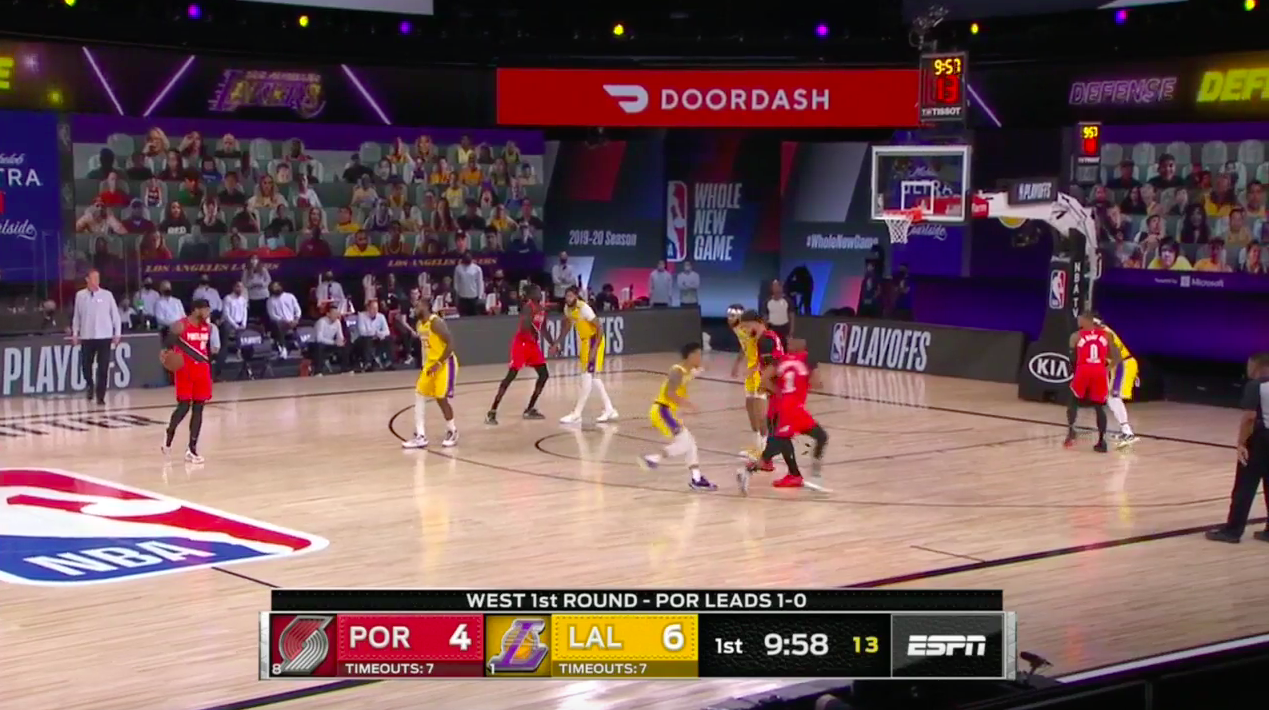
The second time Portland ran the play, also early in the game, LA trailed the flare and got lots of ball pressure, shutting down the play.
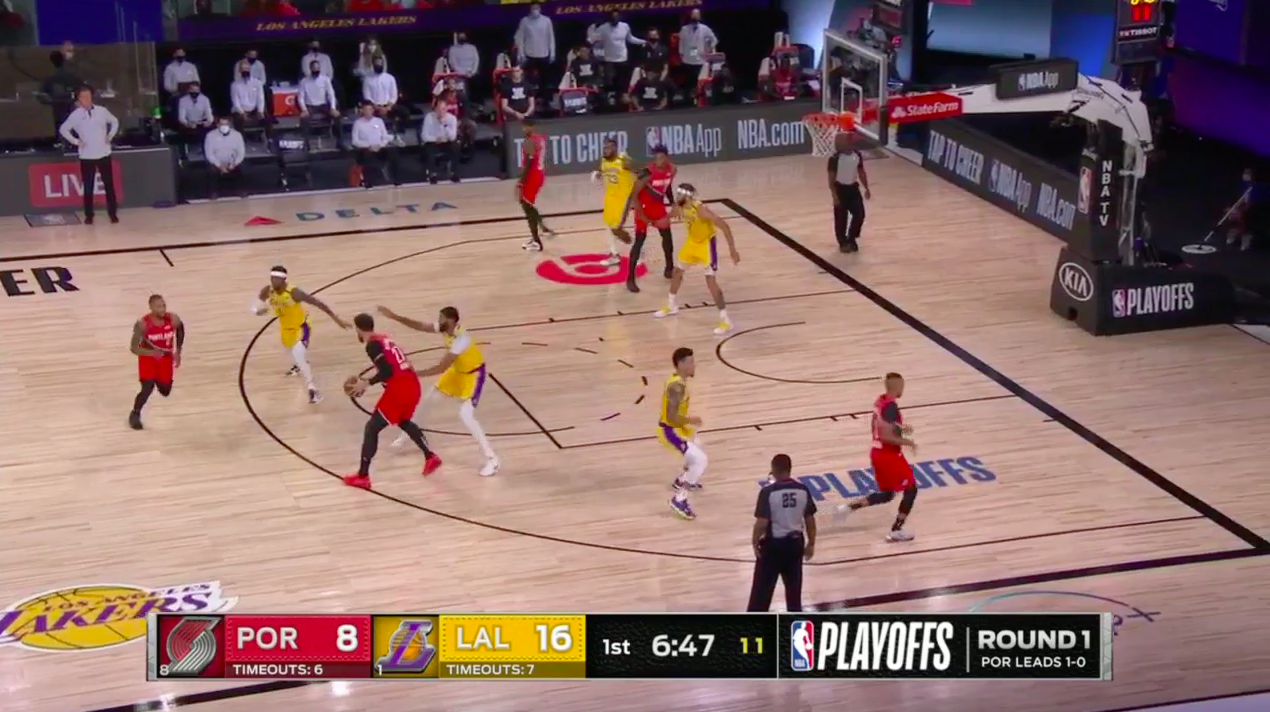
The third time Portland ran it, also in the first quarter, LA defended this play exactly how I recommended, with the flare trailed and going under the pin down, with ball pressure on the passer on top of that. Perfect execution by LA.
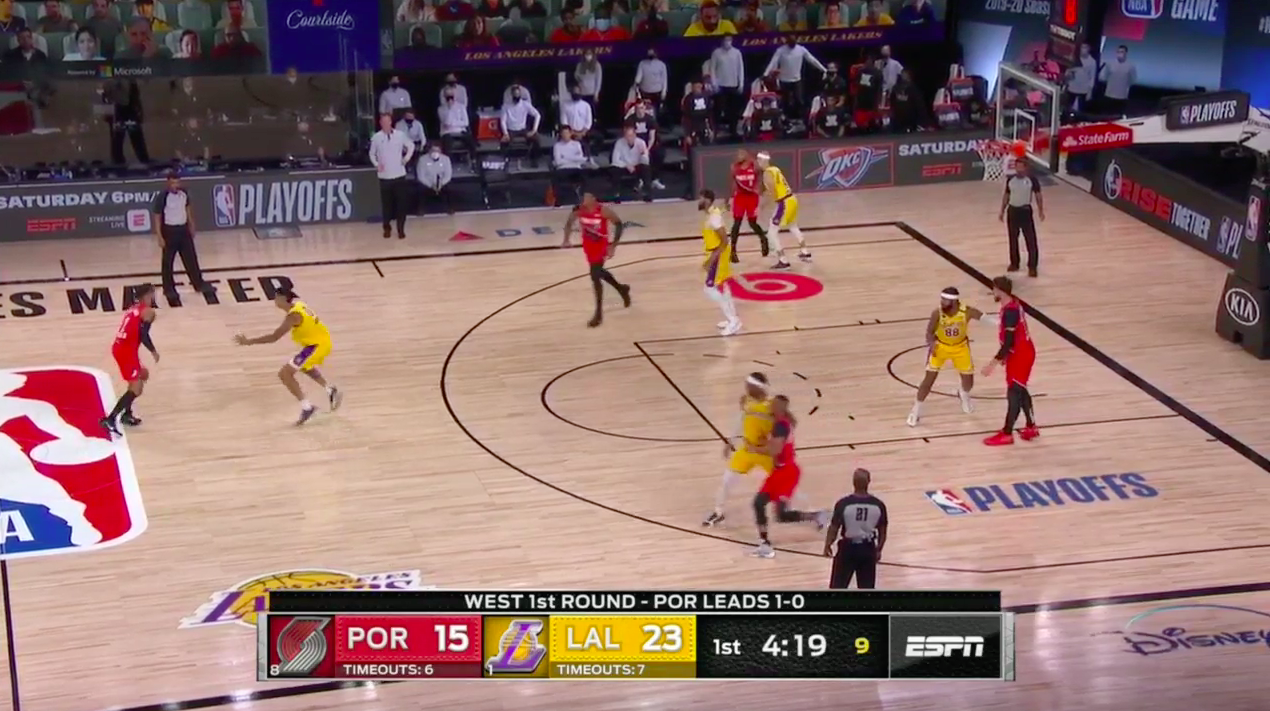
And what do you know? Portland, after running the set 3 times in 6 minutes, didn’t run it again until garbage time.
Double Fist
Also ran right off the bat, less than two minutes into the game, but LA hard hedged to negate the action instead of dropping like they did in game 1, so we didn’t see this play again until the second quarter.
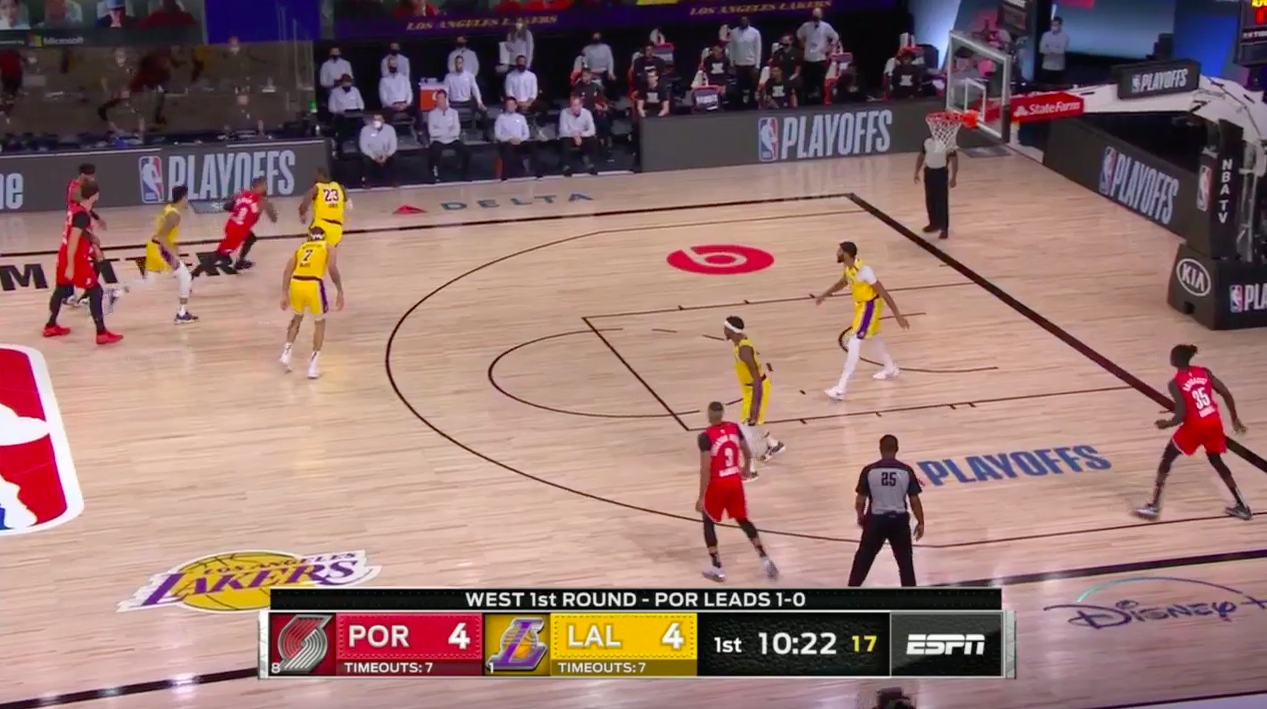
Secondary Break Step Up Screen
Used twice at the start of the 3rd quarter as an adjustment to LA’s ball screen coverages, which we’ll get to later.
Since this was in the secondary break, and the LA defense wasn’t set, they’re more susceptible to these sorts of plays and Portland got around the corner 2 out of 2 times. Here was one attempt with CJ:
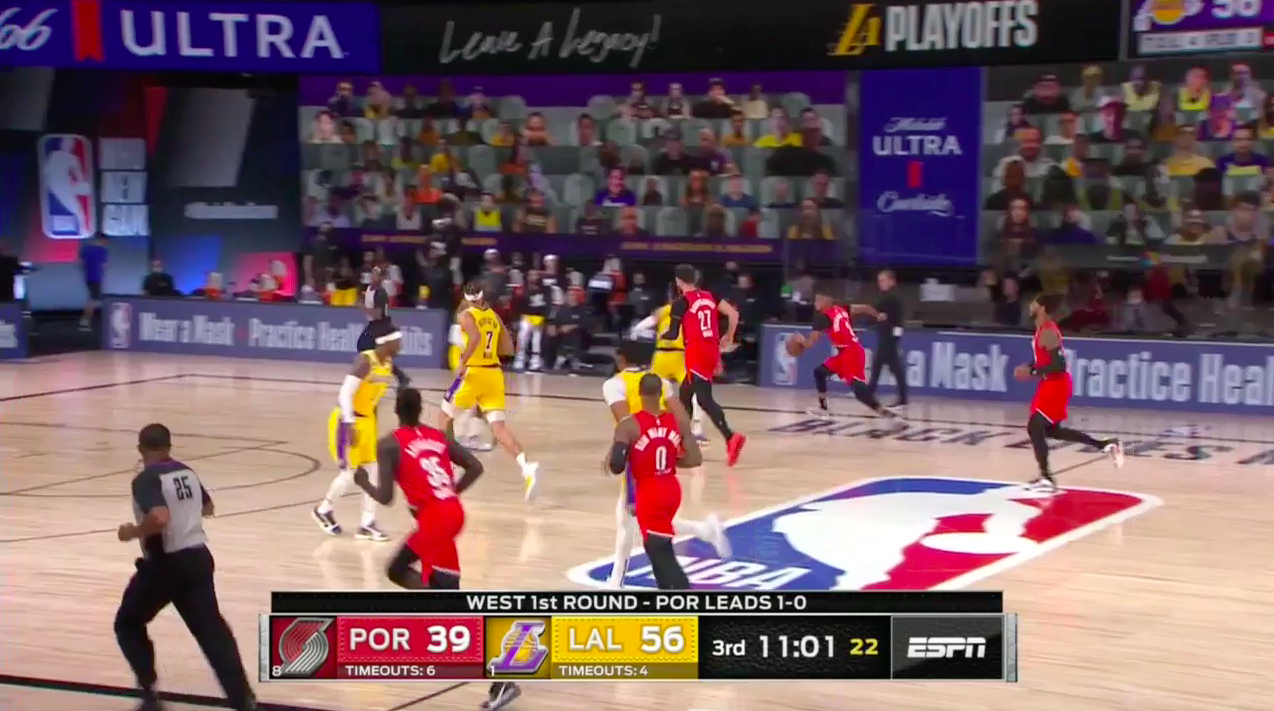
And here’s one time Portland used it with Dame:
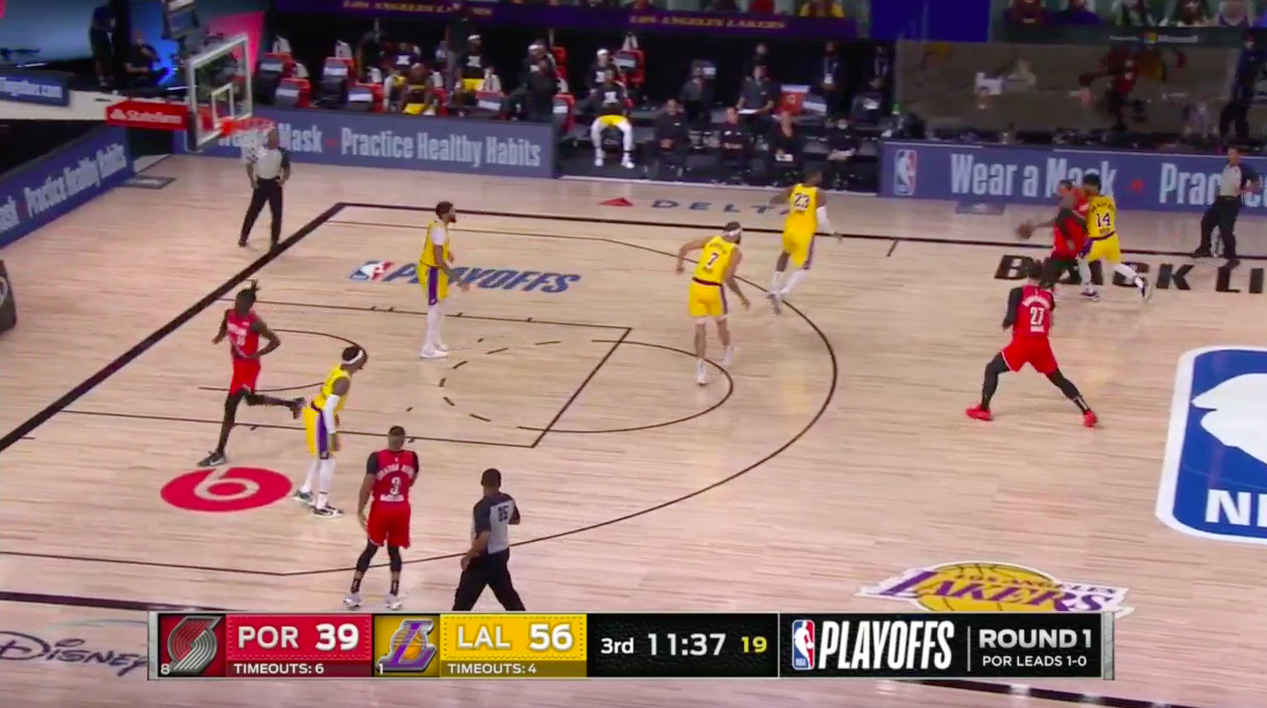
But then they didn’t go back to it, which is inexcusable to me.
Dame Pick & Roll
Going into the series, my written recommendation was to switch when Melo was involved in the ball screen but either hard hedge or blitz when Nurkic/Whiteside/someone else was the screener.
To briefly go over ball screen coverages, here’s a matrix showing some basic option combos, why you’d run them, and what they give up. There’s more that can go into this, and there are more options when you consider the ball handler’s man going over/under the screen, but those are the basics when it comes to what the big man does:
| Coverage | Why Run it? | What it Concedes |
| Drop/Soft Hedge | Stop ball handler from getting to the rim | Pull up 2s and 3s, pick & pop |
| Hard Hedge/Show | Stop ball handler from getting chance to pull up or drive | Slips by screener, short roll |
| Blitz/Double Team | Force ball out of hands of scorer | Slips by screener, immediate pass to screener |
In game 1, LA faced 34 Dame ball screens. If we ignore the 6 they had no hedge on because the coverage was completely blown, we’re left with 28 ball screens that LA defended this way:
- Hard Hedge: used 68% of the time. These shut down the P&R well, as POR scored 0.65 points per possession total on these looks.
- High Ice/Weak: 14%; these shut down the P&R well on small volume; 0.64 PPP
- Weak him to make him go towards the RIGHT, not the LEFT
- This is essentially a hard hedge, just on the other side of the ball screen
- Drop: 18%. Portland torched these for 1.94 PPP
- And POR had 1.83 PPP on the blown coverages. It’s a small sample, but having the same effectiveness with nobody there compared to having a dropping big is telling.
In game 2, here’s how it broke down:
- Hard Hedge: used 58% of the time and gave up 0.55 points per possession
- High Ice/Weak: used 42% of the time and gave up 0.84 PPP
- Not a single drop, which is fantastic.
- Dame had lower volume because he didn’t play in the 4th quarter of game 2, but the ball screens per quarter were close to the same in both games.
So hard hedge if going to his weak hand, and hard hedge and try to force him to reject ball screens to his strong side. And switch if he strings out the hard hedge, but don’t run drop coverage at all and no automatic switches.
LeBron fell asleep on a hedge one time LeBron, and another time he was pretty deep because it was a screen in the secondary break. He tried to recover to hard hedge, but because he was out of position he was beat around the corner. Other than that, the screener’s men in the actions did well.
The guards in the “Weak” coverage messed up several times: KCP twice, Caruso & Green each once. They let Dame use the screen, which normally isn’t the end of the world, but there was no hedge because the Big was in a hard hedge for the reject side of the screen.
LA got away with this and gave up only 0.4 PPP on those 5 looks, but that needs to be cleaned up.
CJ McCollum Pick & Roll
We saw an adjustment from the Lakers defending the CJ McCollum pick and roll in game 2 from game 1. As I had written about recommending pre-series, LA played drop against CJ in game 1, since he’s less of a threat to take pull-up 3s but it might not be worth the risk hard hedging or doubling for the 4 on 3 LA would be giving up once he gets he ball away.
In game 1, we see absolutely no threat from Portland in those 4 on 3 situations, so LA got more aggressive and used the same hard hedge coverage they’d been using against Dame to also defend CJ in the pick and roll, and had good success with it.
In game 1, LA used their “Weak”/high ice coverage once (0 PPP), hard hedged 6 times (0.33 PPP), pleyed drop coverage 9 times (0.52 PPP), and blitzed once (0 PPP).
In game 2, they went to only 1 drop (2 PPP), 2 weak/high ices (0 PPP), and 8 hard hedges (0.63 PPP).
LA adjusted to running far more hard hedges against McCollum, because they realized that instead of conceding his mid range pull ups against drop (which he didn’t hit in game 1) they can shut it down altogether based on what they saw screeners not do in the short roll in game 1. Great adjustment from Vogel, and we’ll see more of this in game 3 unless Portland makes some adjustments to counter.
Portland’s Nurkic Issue
I put together a video on this topic since I see this as the key to Portland’s offense this series. Enjoy!
Trent & Melo Self-Creation
With the P&R negated and little CJ & Dame isolation, the defense isn’t collapsing and Trent & Melo are rarely getting looks as finishers. There’s a clear chain of events with Portland’s offense, and as long as LA can negate the pick & roll and isn’t being burnt in iso, these two players end up needing to be self-creators rather than finishers.
That’s less efficient offense in general, but for them specifically is even more of an advantage to LA, since both have been questionable with it on the season.
For game 2, Trent had:
- 2 points in 10 possessions on self-creation looks
- 9 points on 7 possessions when catching & shooting against LA
- 1 made putback
Carmelo had:
- 5 points in 17 possessions self creating, along with a shooting foul drawn on an 18th possession
- 6 points in 6 possessions catching & shooting
- Melo has passed out on 1 of 19 total post up and iso possessions during postseason play. This, and the poor passing we’ve spoken about previously, is why we see the Lakers sending double teams at Melo in these isolation situations. They know he won’t beat them with passing, so why not drop his efficiency even further self-creating?
The efficiency may be good for select games, but I’m thrilled if I’m the Lakers as long as the ratio of self-creation to finishing is at or better than the 2:1 ratio we’ve seen so far.
The Lakers’ Offense
LA’s Post/Iso Scoring
An ongoing issue for LA this series has been the packed paint they’ve seen from Portland’s base defense against post ups and isolations. This isn’t a new development for Portland, based on how they’ve defended in previous games and what we discussed in the pre-series scouting report.
LA just hasn’t been able to counter well, and that’s led to continued paint packing. It’s not as simple as “hit more 3s,” because often Portland is able to recover to shooters with how stagnant LA is with their shooters weak side. Don’t get me wrong, LA has gotten plenty of open shots this series. They just haven’t been coming from these looks, and that same paint packing has had an adverse effect on the isolation and post up games of LeBron and AD.
6 of 9 Bron post ups were against a loaded up paint in game 2. 2 of 4 were for Davis, and the 2 that didn’t have a packed paint were due to one having good cutting by the Laker player whose man normally would bring the extra help, with AD quickly attacking after the cut. The other had LeBron standing in the position whose defender would normally send help, but Portland didn’t want to leave LeBron, which created space.
Having the PF and C in LA’s small lineups stand towards the top of the key opened the paint once for LeBron in game 1 and once more in game 2. More of this, please.
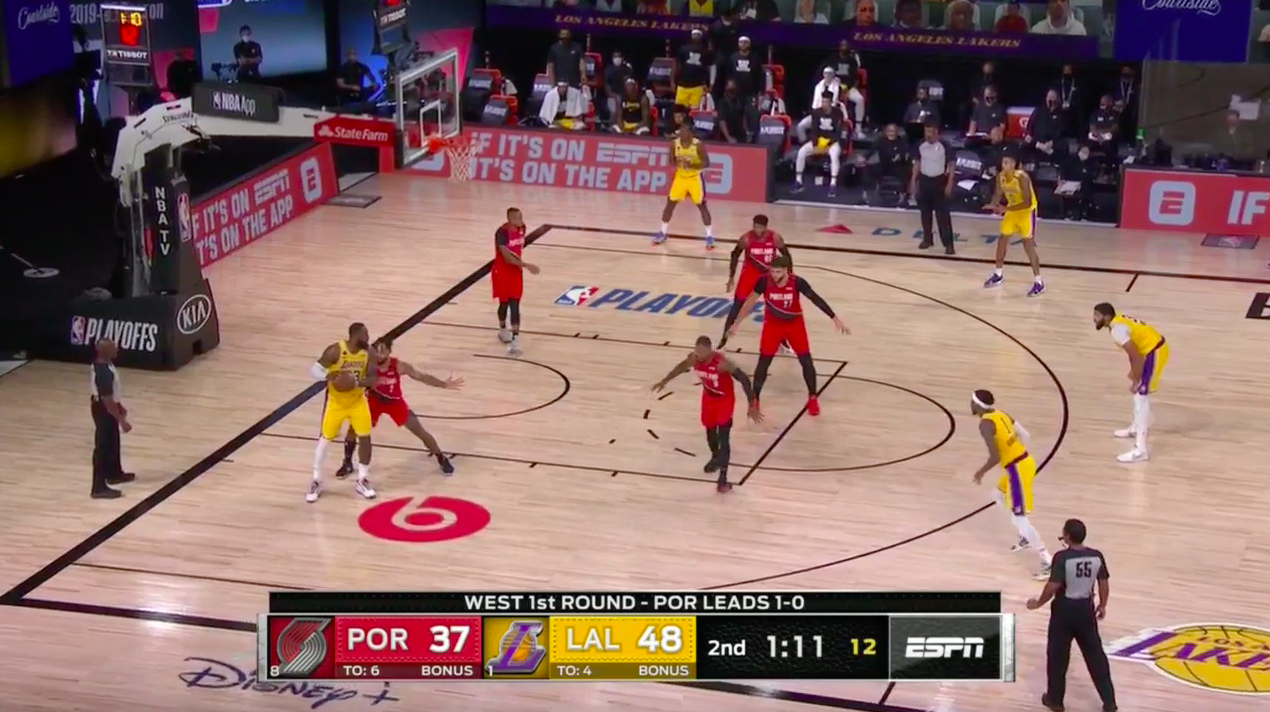
LA scored all 3 times the paint wasn’t loaded up for LeBron and AD scored 1 of 2 times. Combined, those players scored 0.5 PPP on the possessions it was loaded up. So there’s still work to be done to make life easier for LA’s best 2 players.
In game 1, LA tried a couple counters using flare screens and scored twice in 3 chances off of it, but they did none of that in game 2.
But LA did do a couple new things to counter loading up:
1. If the help is coming same-side, have that shooter move or cut. LA went to these options once each.
Here, with the shooter moving to make the closeout more difficult:
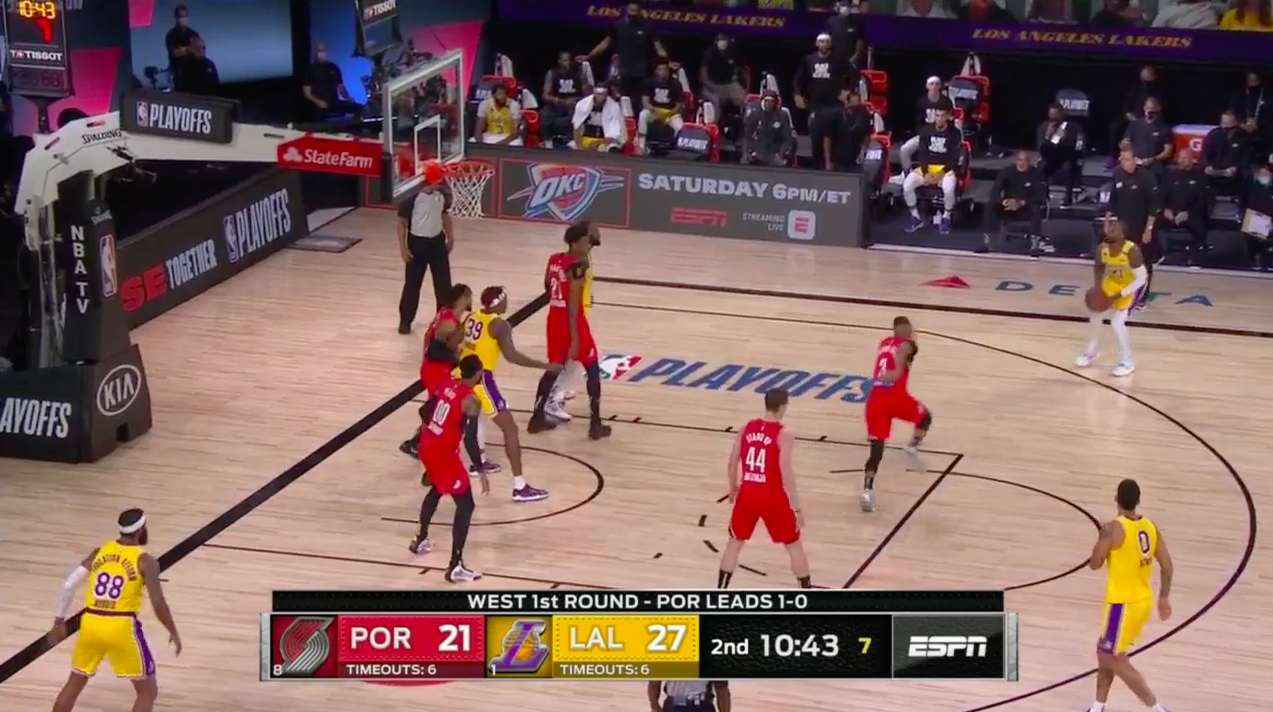
And here, with the player cutting to clear space:
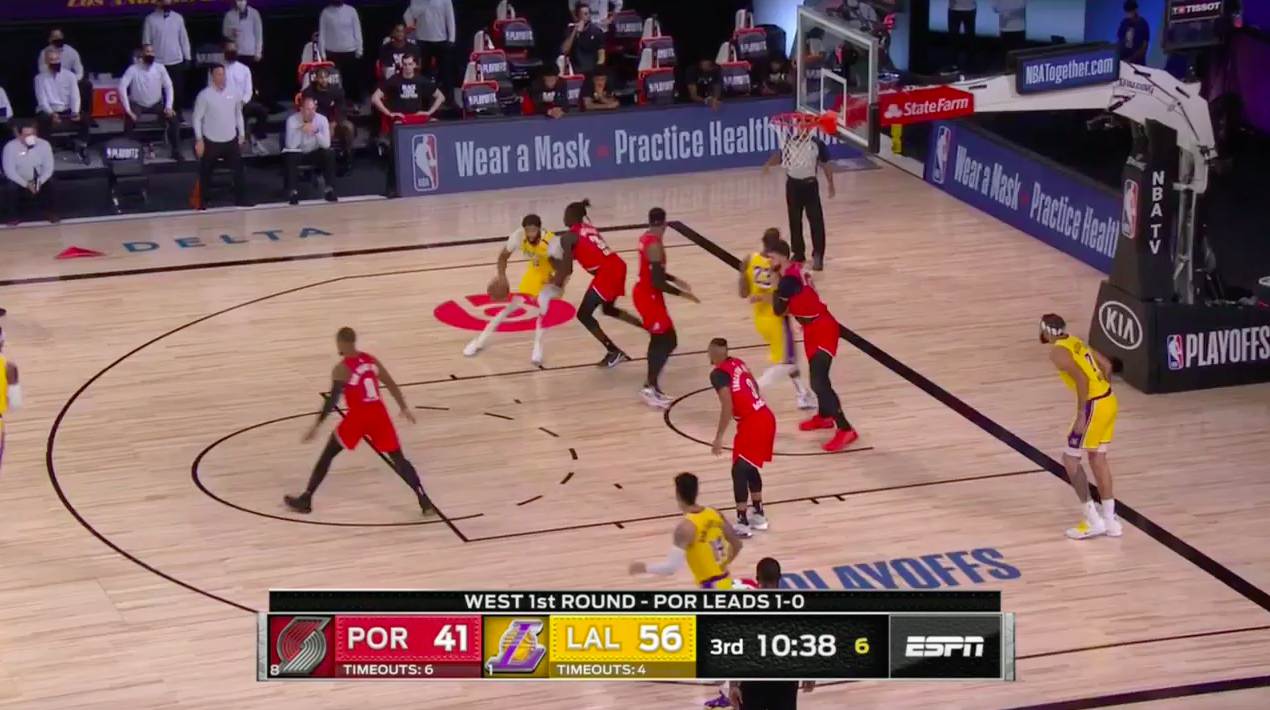
2. Having the Big under the rim either set a flare for a skip pass or get inside position on the defender if there’s 1 guy trying to guard both players.
Howard tries here, but LeBron doesn’t see him:
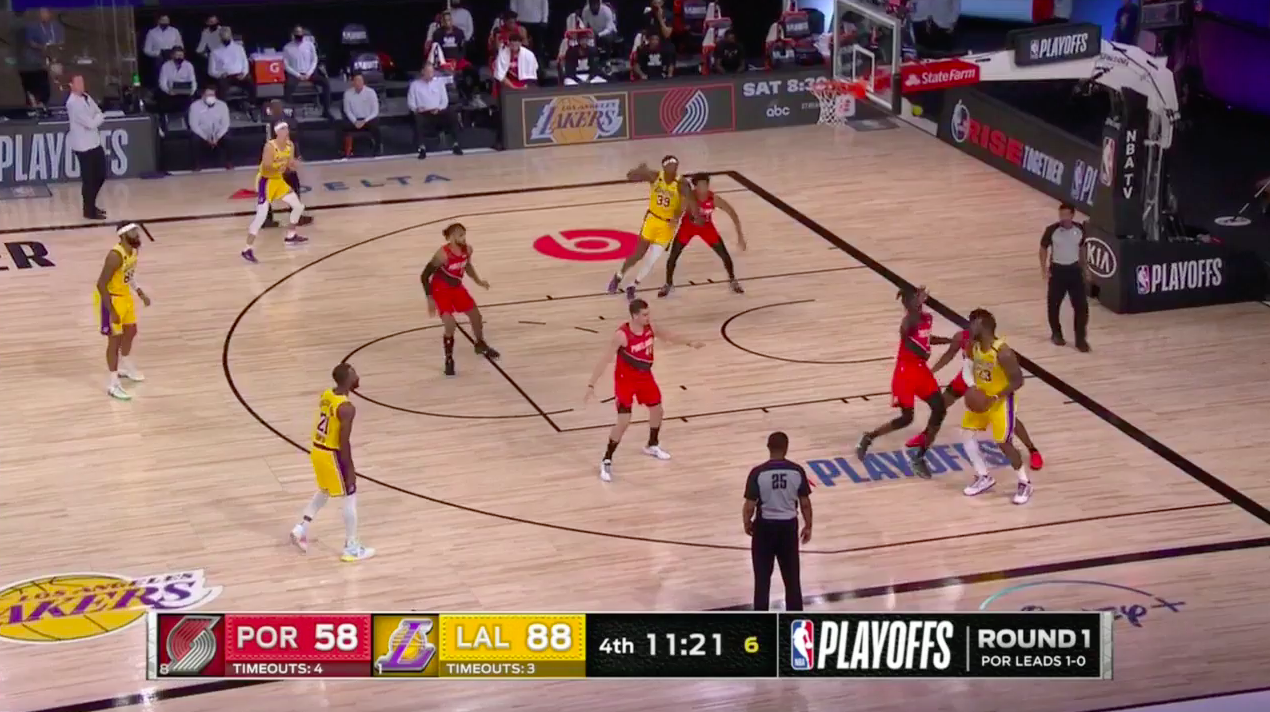
And we sort of see AD do this here:
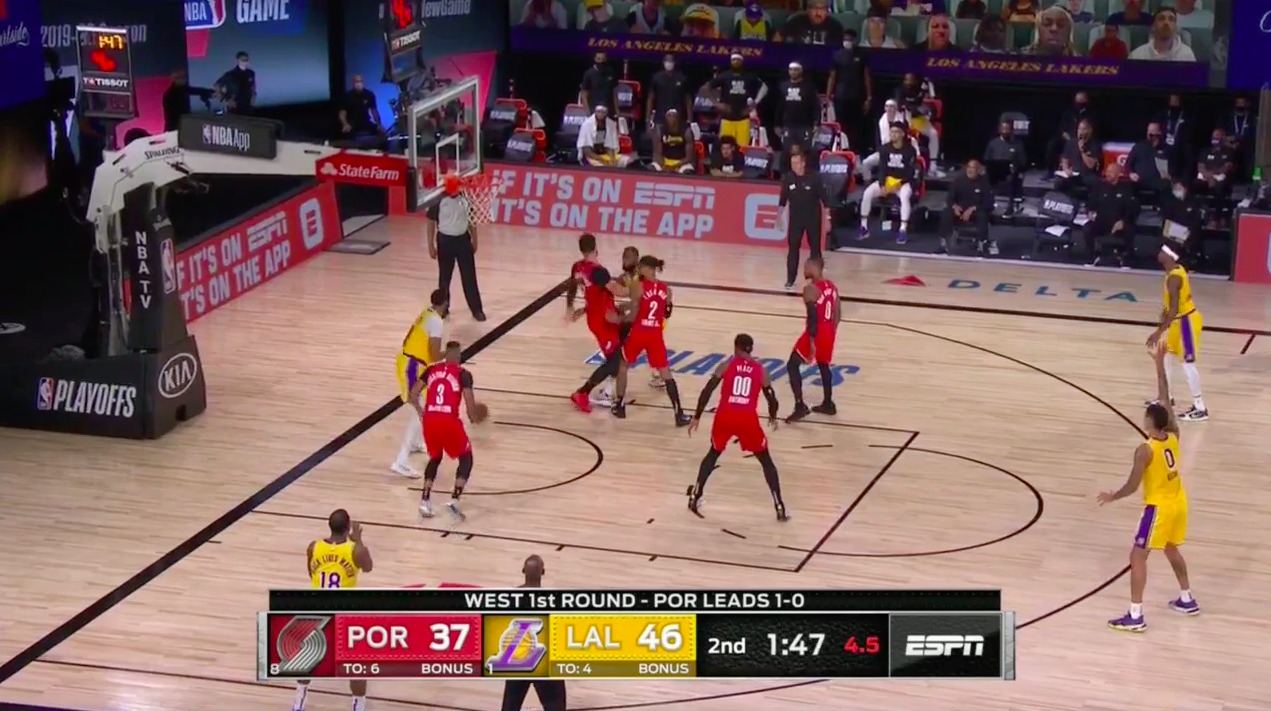
In terms of what they could be doing, having a baseline runner once the second man comes towards LeBron may result in an open shooter in the corner. LA got close to having that on this possession:
Another option is for the Big to set a pin-in flare for the wing if that’s where the help is coming from, and his man is Whiteside/Nurkic worried about the rim and likely wouldn’t be closing out on the shooter. That would’ve worked well here if Dwight were to set the screen:
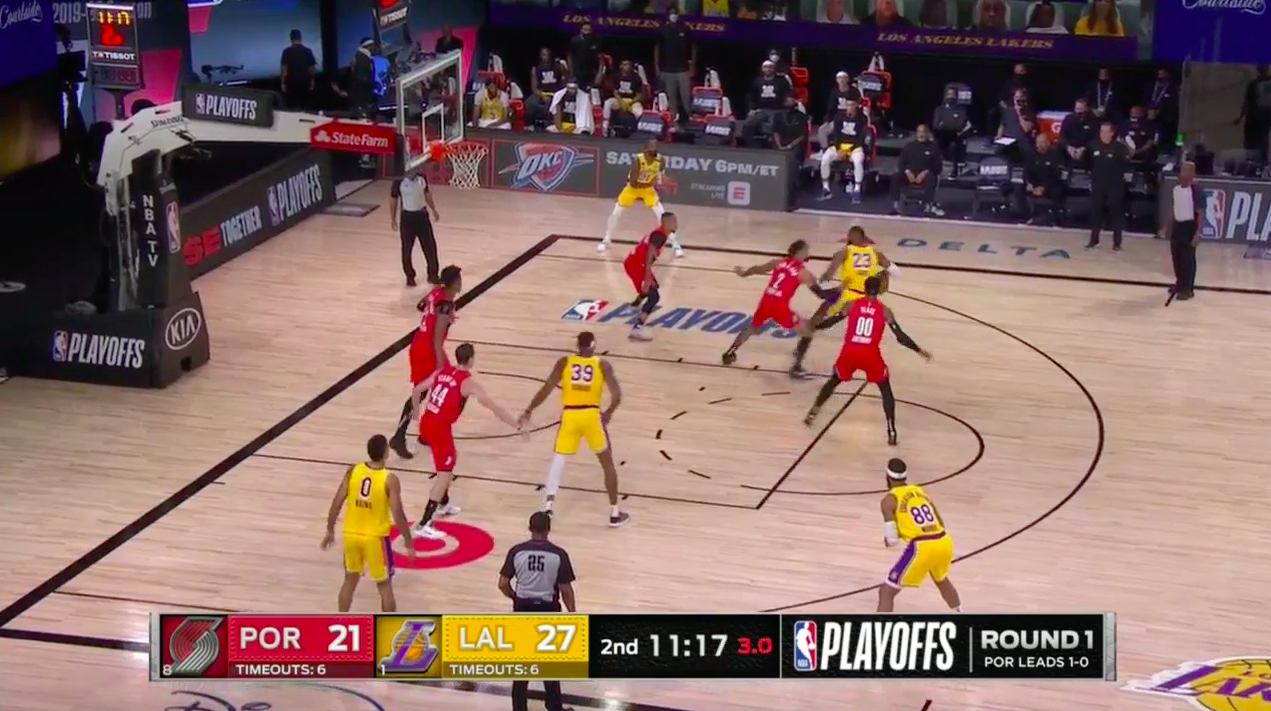
LeBron/AD P&R
We discussed in the game 1 post-game article how the Lakers had struggled with these on the season and in game 1. Well, we saw the volume of these attacks drop from 12 scoring possessions to only 3.
We’ve also seen LeBron’s man go under ball screens, which concedes the Bron pull-up 3 behind the screen. He just hasn’t identified or been willing to take that shot. Because of this, defenses will likely continue going under and negating that action more often and not needing to switch to do so. This is an issue for LA.
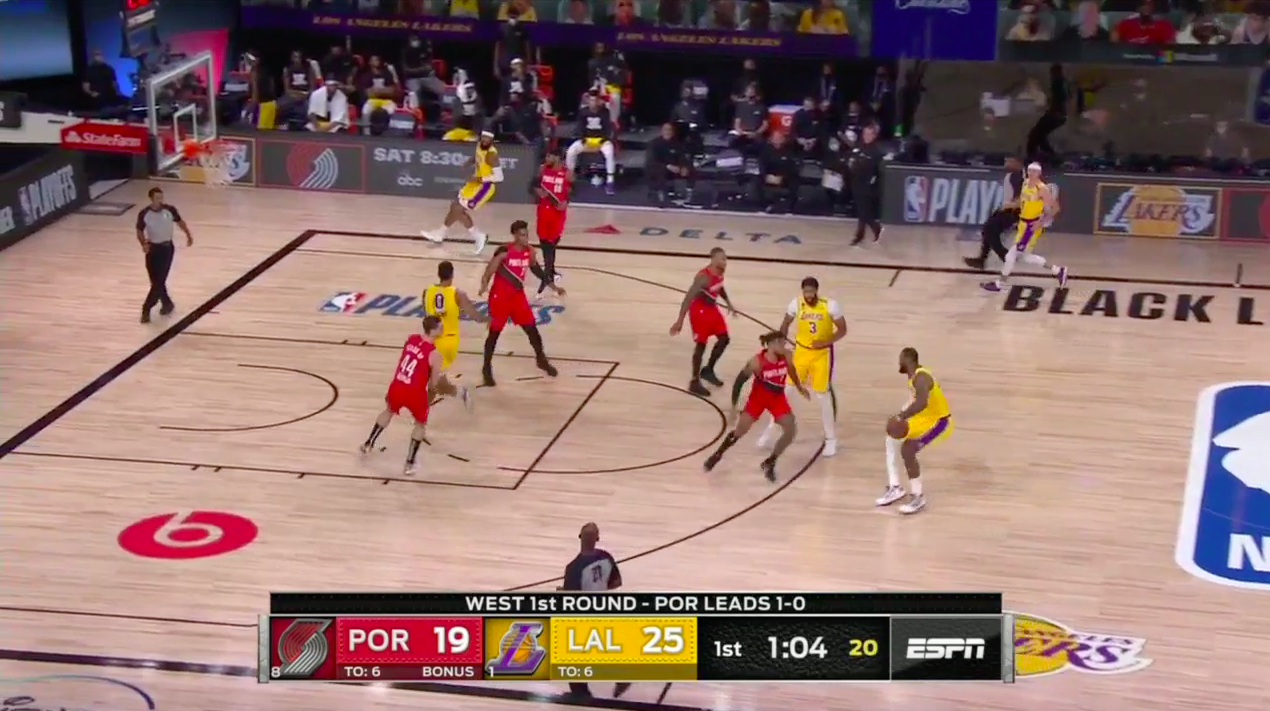
LA doesn’t need this attack clicking to beat Portland, but they’ll need it in subsequent rounds to an increasing degree. Abandoning the action getting your two best players working together in the 2-man game is a bad look, but hopefully we see more moving forward, and the right adjustments to take advantage of how Portland is defending the paint.
I’ll get into the weeds on this for my game 3 post game if LA doesn’t adjust in game 3, but this is an alarming item I have my eye on. It’ll hurt against a potential Houston matchup if the Lakers don’t fix their issues attacking switches and attacking a packed paint.
Inverted Pick & Roll
One new attack we saw from LA was more inverted pick and roll, particularly with AD. This created a new way to pressure the defense with a non-iso primary action that didn’t involve LeBron, and showed promise. When AD ran it, they had 6 points in 5 possessions and were getting some open 3s and attacks on the rim.
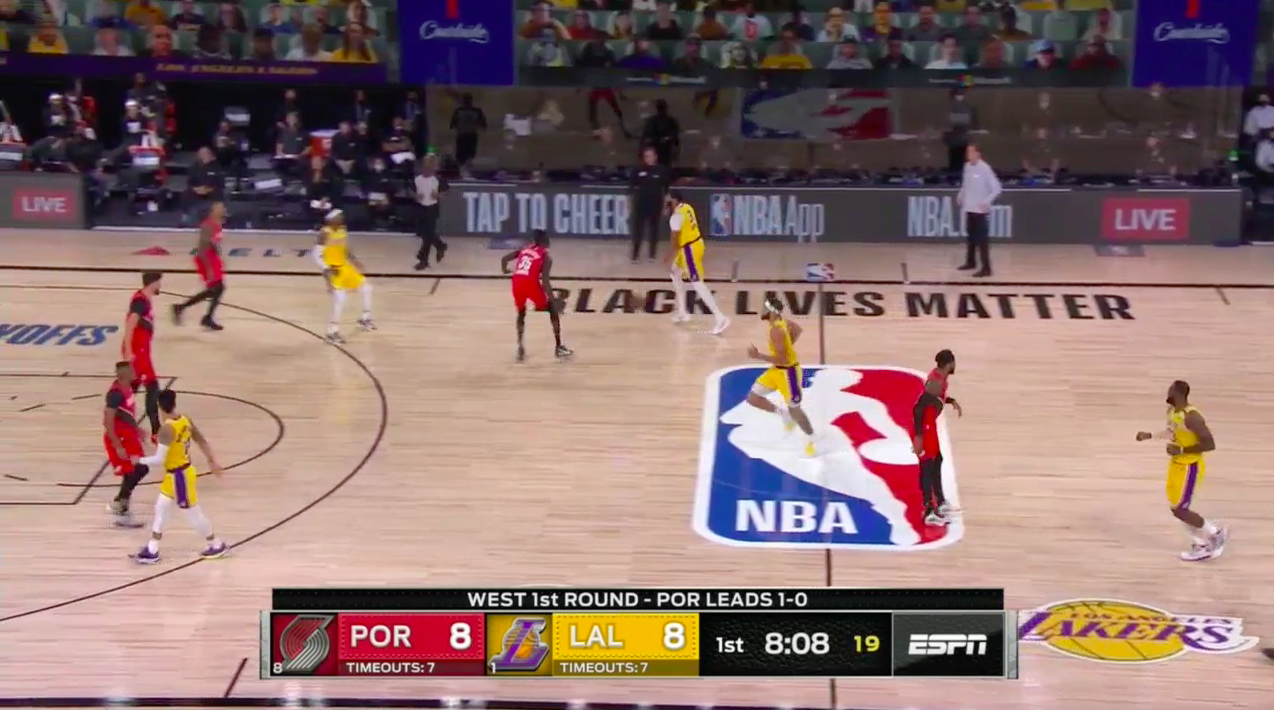
Kuz also ran some P&R with Dwight, some Caruso pick & roll, and even some KCP pick & roll. Kuz and AD in the inverted pick & roll in small lineups gives him a chance to potentially attack the rim against defenders in situations they’re not used to. KCP is better suited to attack in handoffs, based on his skill sets playmaking and driving.
Transition
One area of LA attacking I noticed in game 2 that I had seen, but paid less attention to, in game 1 was their transition attack. So I dug into the numbers.
In game 1, LA had 25 transition possessions and scored 17 points. Very high volume but poor efficiency.
In game 2, LA had 15 possessions and 7 points, which is even lower volume and worse efficiency.
I think I noticed it more this game just due to some of the long passes, but Portland got a better handle on it this game.
That said, it’s an ongoing weakness for the Blazers that LA should look to attack. Portland on the year has given up the 6th highest volume of transition opportunities per game but has the 11th best defensive efficiency. Slightly above average efficiency on defense, but giving up a lot of chances is still great offense to go after, and we’re seeing LA do that.
The second piece of this is that LA’s half court offense hasn’t been all that impressive, pre-bubble, during seeding games, or during the playoffs so far. Beating Portland’s bigs down the court and attacking the rim downhill in transition is a huge advantage for LA and much better than what they’re looking at when the game slows down.
Dominating On the Glass
I don’t care who the Lakers are playing. They’re beating just about anyone with good defense and if they can rebound as high a percentage of their missed shots as they have against Portland.
For putbacks specifically, where LA is getting high quality looks right at the rim on those putbacks rather than kicking it out and resetting with ~14 on the shot clock, the Lakers have averaged 11 opportunities per game this series. That’s up from just under 7 per game on the year, which gave LA the 2nd highest volume (while they also had the 2nd highest efficiency). 11 per game is outright dominance.
If they’re getting 10+ extra possessions per game and defending the way they are, it’s going to take more historically poor shooting nights to beat them.
Anthony Davis’ Explosion
AD going off was much needed and powered the Lakers to a victory. But it’s important to know how it happened. Like we said in the pre-series article, AD doesn’t have a great matchup against Portland in the post or isolating based on how the Blazers load up the paint.
This rang true, with AD scoring 0.5 points per possession in the post, and 0 in 1 in perimeter isolation. When he did have success, it was when he was going through people, not trying to finesse around them. AD has the talent to do this, but we need to see more aggression from him to have that materialize.
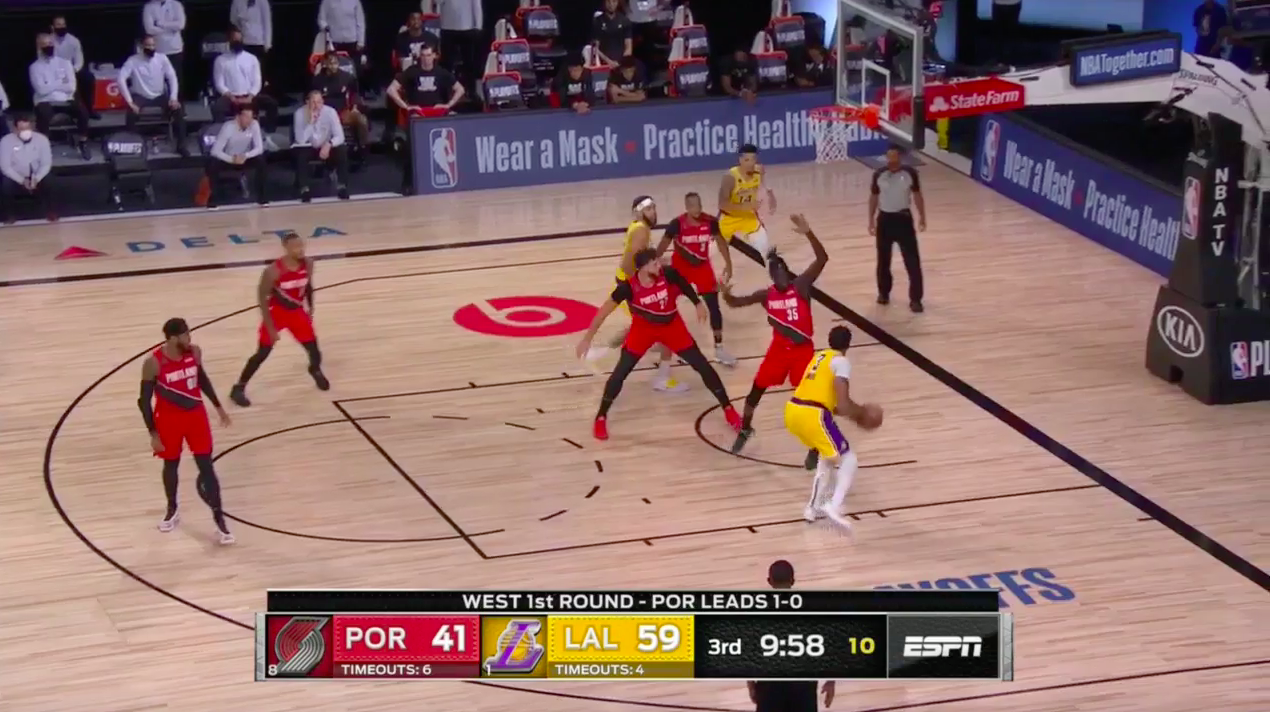
Ignoring those iso looks, AD scored 29 points in 22 possessions with everything else (1.3 PPP). That’s fantastic. Overall on the series he’s at 0.7 PPP for his entire iso game and 1.2 PPP everywhere else, despite missing a lot of 3-pointers in the first game of the series.
One last misconception worth mentioning is around AD’s time at center. He played 58% of his minutes at center in game 1 and 50% in game 2. Is that enough for this series? It’s probably close to it.
When LA does go small, AD has been less the one to attack. Where LA has targeted that offense with mismatches when the opponent doesn’t match the small lineups is with the 4, which in game 2 was Kuzma (when LA went after it).
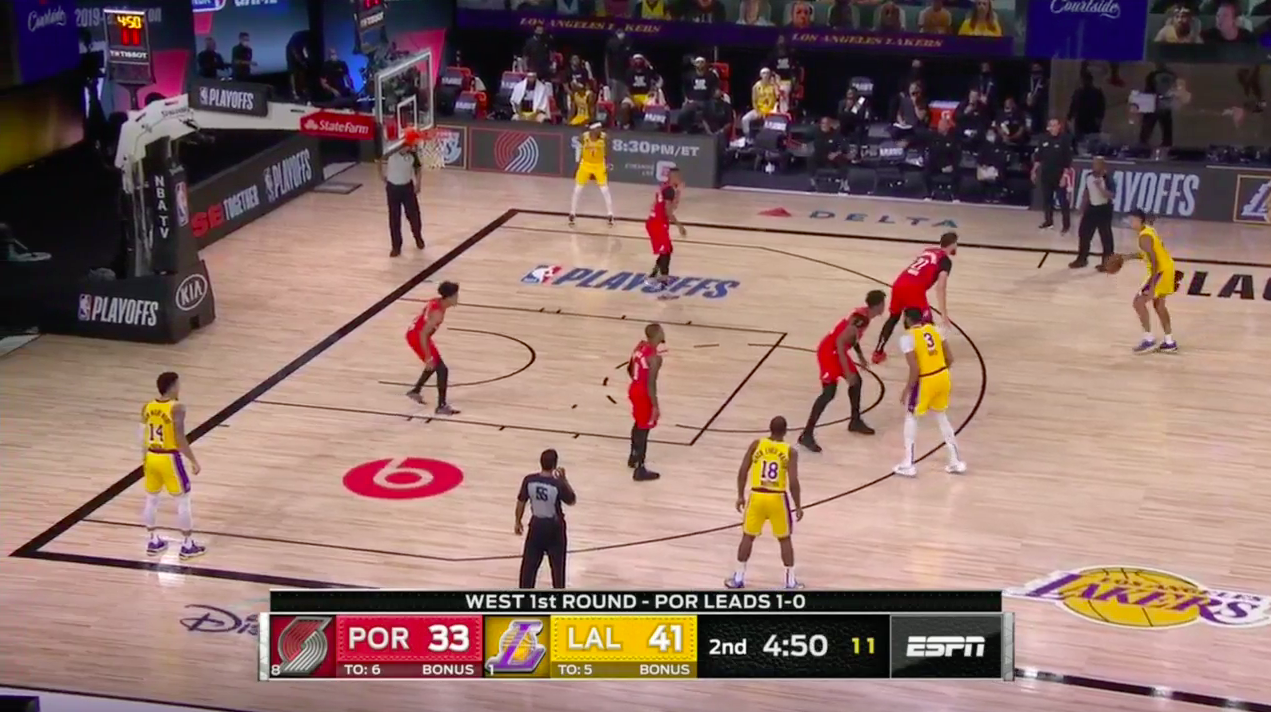
To me, Kuz driving is more to LA’s advantage than him dancing around and taking step-back 3s, which is how he attacked in game 2. It’s awesome when he has it going, but with an eye towards harder matchups in later rounds I’m not sure if that’s where LA wants to hand their hat.
New/Adjustments We Saw in Game 2:
- LA: AD & Kuz inverted P&R; 7 times in 3 quarters
- LA: Exploratory: Logo P&R w/AC; 2 times in 3 quarters
- LA: hard hedge CJ instead of drop
- LA: minutes for Dion & JR, who with some mixed results at least provided some self-creation ability and willingness to attack closeouts and try to playmake in ways we see less of for Danny Green or KCP.
- LA had Different counters to paint packing, but not necessarily more, so I’m not sure we’ll count that
- POR: handoffs to combat hard hedging
- POR: step up secondary break ball screens to combat hard hedging
Adjustments for game 3:
- POR: Make changes addressed in my Cranjis’ Corner video. If not, this series is likely over.
- POR: More handoff situations & secondary break ball screens as a workaround to LA’s ball screen coverage. They did some in game 2, but not nearly enough to give themselves a chance to win the game.
- POR: If LA adjusts with counters to the paint packing, double quicker and harder on the LA post ups to make those skip, dump off, and kick out passes harder to make. It’d be time to escalate and double down on something that’s worked, rather than backing off and letting LA dominate the paint with drives and clearing room on isolations and post ups.
- LA: When LeBron is off the court, more handoffs for KCP and more AD or Kuzma inverted ball screen would give the Lakers offensive creation options other than AD post ups or perimeter isolations to pressure the defense.
- LA: More of that horns play that worked in game 1, which you can read about in this breakdown. Offense like this lets LA get LeBron off-ball to create scoring opportunities for him.
- LA: Attacking 2-3 zone of Portland’s in out of bounds situations smarter. It’s had a smaller impact so far but could have an impact in a big moment. I’ll cover this more after game 3.
Wrap Up
That’s it for today! I feel good about the series moving forward, but do feel the Lakers still have long-term issues they need to address and ideally would figure out this series before facing Houston, who is looking more and more able to attack the Lakers in specific weak areas to be a tough matchup in round 2.
This series is far from over, but the onus is now on Portland to make key adjustments in their pick & roll attack to give themselves a chance to compete. If not, this series is over.

